|
|
Case Study: Computers in Diving and Marine Exploration
MobileDemand T7000 rugged tablet PC boosts safety, productivity, data capture on marine underwater and exploration expedition in the Sea of Cortez
(by Conrad H. Blickenstorfer -- photography by Carol Cotton)
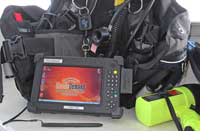 In July of 2012, editors of RuggedPCReview.com and ScubaDiverInfo.com traveled on the 110-foot Rocio Del Mar to the Islas Grandes, a group of eleven remote and uninhabited islands located in the upper third of the Sea of Cortez, also known as the Gulf of California. The purpose of the expedition was to test a variety of rugged and underwater equipment while surveying the status of the whale shark, dolphin and sea lion populations these islands are famous for. Part of our test equipment arsenal was a MobileDemand xTablet T7000 rugged tablet PC. The handy tablet computer, impervious to the demanding conditions onboard, would become a valuable asset to the team in more than one respect.
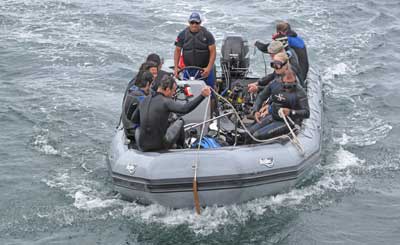 Keeping track of dive gear, lights, cameras, housings, batteries, chargers, storage cards, adapters and cables onboard a live-aboard vessel with small staterooms and limited storage was a challenge we had assigned to the T7000 tablet via check lists and spreadsheets. Keeping track of dive gear, lights, cameras, housings, batteries, chargers, storage cards, adapters and cables onboard a live-aboard vessel with small staterooms and limited storage was a challenge we had assigned to the T7000 tablet via check lists and spreadsheets.
The team's explorations began with a stop at Isla Angel de la Guarda (Angel island), an uninhabited nature preserve that measures about 360 square miles and rises to 4,300 feet. It possesses a stark beauty, dramatic rock outcroppings, and strong currents. Anchoring at dive sites was not an option and so all diving was off zodiacs. We had ample opportunity to observe sea lion colonies. There was also an amazing wealth of macro life, including various species of colorful nudibranchs.
The next stop was Bahia de los Angeles, a coastal bay on the eastern shore of Baja California. The almost fully enclosed bay is part of a biosphere reserve, and we came here in the hope of seeing whale sharks. Whale sharks are filter feeders and the largest living fish on the planet. They can be over 40 feet in length, weigh almost 40 tons, and go back some 60 million years. They pose no danger to divers and snorkelers, and they can be observed as they are slow swimmers. With the help of a local operator we found about half a dozen whale sharks feeding off krill on the surface and observed them in the water for several hours.
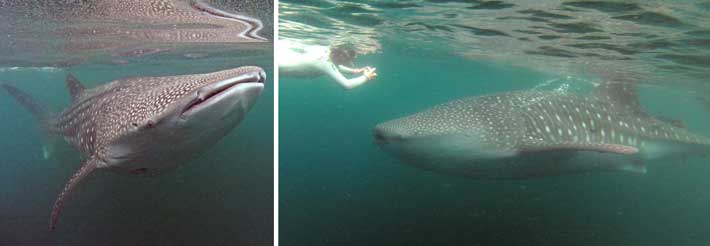
The pictures above and below, taken by the team with GoPro Hero2 cameras in GoPro flatlens housings, show some of the whale sharks we encountered at Bahia de los Angeles.
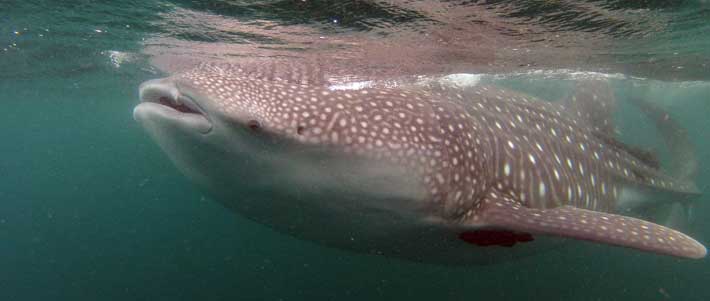
Computers in diving and marine exploration
Different types of computers play major roles in dive expeditions and marine explorations. Dive computers, while very different from laptops or tablets, are crucial life support equipment for scuba divers. Logs from wrist-mounted dive computers can be uploaded into mobile computers for analysis and documentation. Mobile computers are used for trip notes and narrative, logistics and scheduling, image and video storage and pre-processing, as well as geotagging and navigation.
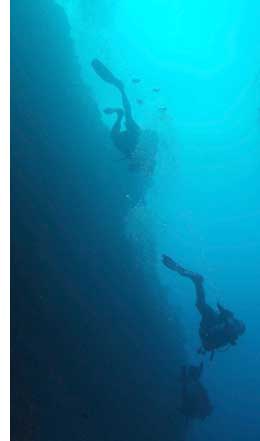 Scuba diving is an equipment-intensive activity where there is essentially no margin for error. When exploring a near-vertical wall a hundred feet below the surface, the divers rely on their regulator to supply air, and their buoyancy compensator vest to keep from dropping into the abyss below or ascending too fast and risking an air embolism or other life-threatening conditions. Scuba divers learn the rather complex physics of diving and how to use dive tables to plan exposure to the pressures of depth and allowable depths on repetitive dives. While dive tables remain an important backup, serious divers today rely almost exclusively on dedicated dive computers. Scuba diving is an equipment-intensive activity where there is essentially no margin for error. When exploring a near-vertical wall a hundred feet below the surface, the divers rely on their regulator to supply air, and their buoyancy compensator vest to keep from dropping into the abyss below or ascending too fast and risking an air embolism or other life-threatening conditions. Scuba divers learn the rather complex physics of diving and how to use dive tables to plan exposure to the pressures of depth and allowable depths on repetitive dives. While dive tables remain an important backup, serious divers today rely almost exclusively on dedicated dive computers.
Dive computers, either wrist or console-mounted, keep track of depth, dive time, water temperature, remaining bottom time, decompression stops, and remaining air. But their major task is to provide information to prevent nitrogen bubbles from forming inside the body as the diver ascends and the nitrogen gas absorbed under increasing pressure re-expands. To complicate matters, the human body includes many different tissue types, some of which, like cartilage and bone, absorb nitrogen very slowly whereas others, like lung tissue, absorb and release nitrogen much more quickly. Dive computers use mathematical models to calculate nitrogen on and off-gassing in these multiple tissue groups, tracking safe absorption and expulsion.
In an additional twist, our dive team used a 32% oxygen-enriched air mixture called Nitrox that reduces nitrogen absorption and therefore boosts allowable bottom time as well as minimizing post-dive fatigue. Performing all those vital tasks were Uwatec air-integrated dive computers that wirelessly communicate with transmitters attached to the regulator's first stage where they monitor remaining air pressure. Using a wireless connection eliminates the need for an air-hose to a pressure gauge, thus decreasing the danger of getting entangled, and allowing the dive computer to calculate remaining air time, exertion levels and current and average gas consumption.
Dive computers must be completely reliable as a diver's life can depend on it. Their batteries can last for hundreds of dives. Dive time stayed at different depths determines how much remaining safe dive time remains, and what decompression stops the diver must make, if any. The picture below shows a screen capture of a typical dive computer companion software application (we used Uwatec SmartTrac), and shows one of our dives at San Pedro Martir, a remote one square mile island that is officially protected as part of the Islas del Golfo de California Reserve:
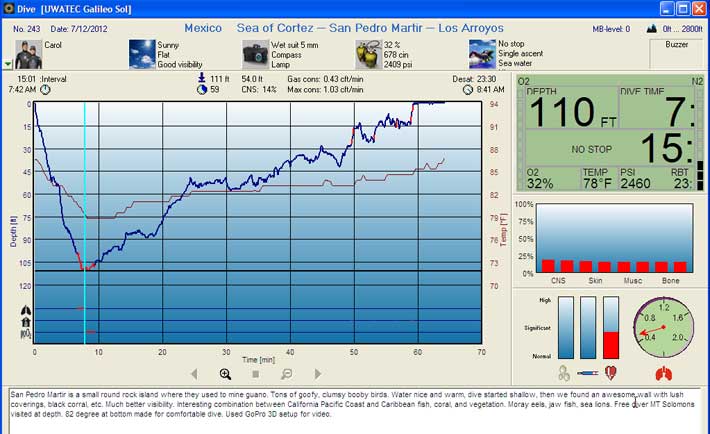
Dive computers have programmable alarms and settings, and usually work in conjunction with a desktop or notebook computer application. Most dive computers datalog the entire dive so that it can be uploaded into the desktop software. In the past that meant getting back to camp or cabins to upload and analyze the dive data and fill out the dive logs. That meant there could be several hours between a dive and writing the log, potentially forgetting invaluable data and detail. It also meant a delay in being able to visually inspect the dive profile, exertion levels, gas consumption, tissue saturation levels, as well as examining alarms.
Using the MobileDemand T7000 rugged tablet PC on the Rocio Del Mar
Using the xTablet T7000, an ultra-rugged tablet PC from MobileDemand, as a dive and expedition support computer made our work simpler and safer. We had the tablet on the exposed dive deck of the Rocio Del Mar, allowing us to upload dive data upon emerging from the water using a USB-based IR adapter that communicated with the Uwatec SOL dive computers. This meant we could enter data and impressions immediately after a dive when the dive was still fresh in our minds and we remembered all the details. It also gave us the opportunity to change or fine-tune dive computer settings for the dives conditions at hand. The image below shows team members examine uploaded data after a dive.
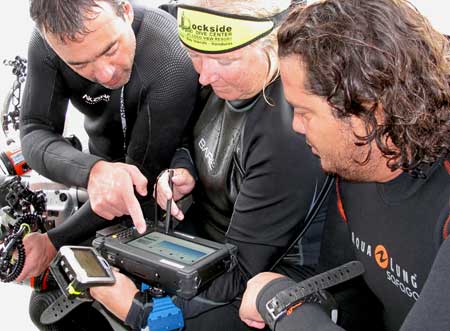 In order to use a computer on a dive boat, it must have a sunlight-readable LCD display. The T7000's bright daylight-readable screen was well suited for use outdoors, and even in direct sunlight. During our week-long expedition we encountered a lot of bright sunshine as well as a good deal of saltwater splashing and dripping. The T7000 screen was up to the job and remained perfectly viewable under all conditions. In order to use a computer on a dive boat, it must have a sunlight-readable LCD display. The T7000's bright daylight-readable screen was well suited for use outdoors, and even in direct sunlight. During our week-long expedition we encountered a lot of bright sunshine as well as a good deal of saltwater splashing and dripping. The T7000 screen was up to the job and remained perfectly viewable under all conditions.
While the covered dive deck of the Rocio Del Mar provided protection from the elements, it was outdoors in the wind and mist, and amidst a lot of wet and dripping dive equipment and divers. Being used on the dive and observation decks also included exposure to surf, spray and the occasional wave washing over a deck.
This is where the T7000 tablet's IP65 sealing came in handy. It is not submersible, but the "5" in the rating means protection against low pressure water jets from all directions, so water spray on a dive boat won't hurt it. Text can be small on the 7-inch 1024 x 600 pixel display, but it remained clearly visible at all times. Operation of the resistive touch screen with the stylus, of course, is unaffected by liquids that would render a capacitive touch screen inoperable.
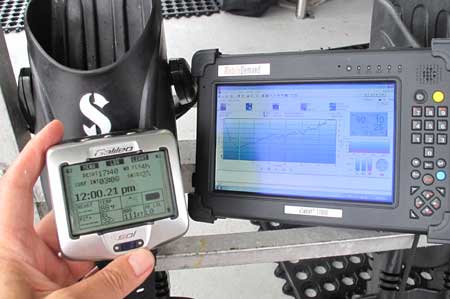 Space is severely limited on live-aboard vessels both in cabins and on deck. The T7000's handy size (8.8 x 5.7 x 1.56 inches) and weight (about 2.5 pounds) made it fit and usable where our bigger (and non-rugged) MacBook Pros didn't. The low weight of the tablet was also appreciated by a team already burdened with scuba tanks, cameras and lots of other bulky equipment. Space is severely limited on live-aboard vessels both in cabins and on deck. The T7000's handy size (8.8 x 5.7 x 1.56 inches) and weight (about 2.5 pounds) made it fit and usable where our bigger (and non-rugged) MacBook Pros didn't. The low weight of the tablet was also appreciated by a team already burdened with scuba tanks, cameras and lots of other bulky equipment.
Also much appreciated was the T7000's long battery life. The dual extended batteries packed a total of 76 watt-hours, more than enough to make the MobileDemand tablet remain reliably available over the team's three or four daily dives and excursions. In fact, battery life was so long as to be a non-issue.
On a dive expedition boat in the middle of the Sea of Cortez, the difference between a rugged and a non-rugged computer is tremendous. A rugged device can be used everywhere, a non-rugged one is strictly confined to a dry cabin. The T7000's ruggedness afforded complete peace of mind. Dive decks are a tough place for a computer. It's wet, it's slippery, and there's lots of hard, heavy gear that can and will fall. Dive decks aren't a place for notebooks and media tablets, but the MobileDemand xTablet fit right in.
Not many recreational divers transfer the data from their dive computers into a notebook for analysis, even though doing so offers a potentially invaluable record of their dives. On professional assignments, though, uploading and analyzing dive data is pretty much mandatory. Having an appropriate mobile computer right there on the dive deck with all the other gear makes uploading and analyzing immediately after dives possible. This generates much improved records and, if something were to go wrong, may provide potentially life-saving information. While almost any notebook computer could be used for uploading, in real life, on a real dive deck, the handy size, ruggedness, outdoor-viewability and superior battery life made the xTablet T7000 perfect for the job.
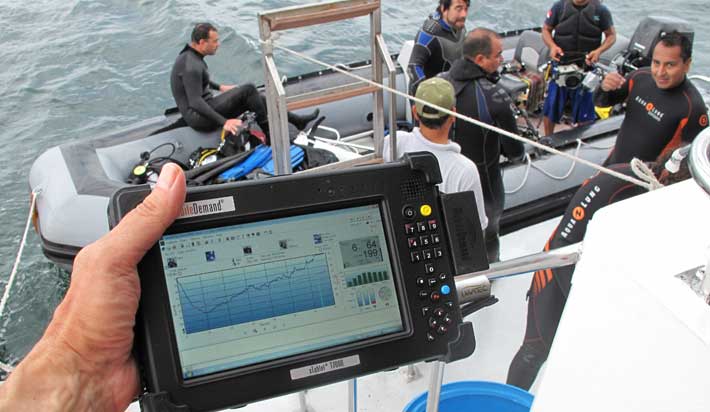
The MobileDemand tablet came in handy for other tasks as well. The team used it to keep track of review product data, photo and video shoot data, assignment check lists, product manuals and as a general document repository for their various projects.
During the trip we also examined the T7000's integrated GPS to determine position, speed and heading of the Rocio Del Mar. While most smartphones and tablets come with GPS, its proper functioning almost always requires a wireless data connection, which we did not have on the Sea of Cortez. Windows-based GPS, on the other hand, works anytime and anywhere. We installed free or demo versions of some of our favorite marine navigation applications, including Polar Navy's PolarView navigation package and PolarCOM NMEA instrument display; the Sea Clear II chart plotter and GPS navigation software; and the Fugawi Marine ENC GPS navigation software. All worked well with the T7000 and provided insights into the use of rugged, sealed tablet PCs for marine navigation. Finding appropriate marine ENC or RNC charts for the Sea of Cortez was more difficult. For US waters, NOAA and its Office of Coast Survey offer detailed, free charts for downloading, but outside of US jurisdiction, you need to locate and buy commercially available maps. The picture below shows the Polar Navy screen and interface on the T7000 (left) and a screen snap of a map of the waters off San Diego.

As far as the whale shark, sperm whale, dolphin and sea lion populations go, the expedition report was mixed. We saw a number of feeding whale sharks in the Bahia de los Angeles, very large schools of bottlenose dolphins, plenty of sea lions, some pilot whales, but no sperm whales. Overall, Mexico's efforts in marine preservation, as well as those of various marine parks and reservations, seem to be paying off. Of all the dive locations we have encountered, those in the Sea of Cortez remain among the most untouched and least damaged.
Our equipment, including the MobileDemand T7000 rugged tablet PC, worked flawlessly. Keeping track of our dives, storing and viewing pictures, keeping track of shoots and assignments, and having a Windows computer whenever and wherever we needed it contributed to the team's productivity, adherence to schedules, as well as safety and documentation.
– Conrad H. Blickenstorfer, August 2012
FOR MORE INFO:
MobileDemand
SaveTheMantas.org
Rocio Del Mar
|
MobileDemand xTablet T7000 Specifications
|
| Added/changed |
07/2012
|
| Type |
Ultra-rugged Tablet PC
|
| Processor |
Intel Atom Z530P, 512KB L2 cache, 533MHz FSB |
| Processor speed |
1.60GHz |
| OS |
Windows 7 Professional |
| Chipset Controller |
Intel US15W with integrated graphics |
| Memory |
2GB DDR2 RAM |
| Display type |
Sunlight-readable 7.0-inch "xView" Hi-Bright (500 nits) TFT with LED backlight |
| Display resolution |
WSVGA 1024 x 600 pixel |
| Digitizer/Pens |
Resisitive touchscreen |
| Keyboard |
Backlit 25-key numeric keypad with additional keys |
| Storage |
32/64/80/128GB Solid State Drive or shock-mounted 120GB 1.8 inch Hard Disk |
| Expansion |
1 SD Card, 1 PCIe |
| Housing |
Lightweight magnesium alloy chassis, plastic body, rubber bumpers |
| Operating temperature |
-4 to 122 degrees Fahrenheit (-20 to 50 degrees centigrade) |
| Vibration/Drops |
MIL-STD 810G, Method 516.6, Procedure IV: 26 repeated drops to plywood over concrete from 48 inches
|
| Enclosure Class |
IP 65; Rain: MIL-STD 810G, Method 506.5, Procedure II, 4" per hour, 40psi for 10 minutes on all axes |
| Hazardous materials |
unknown |
| Regulatory |
FCC Class B, FCC/SAR, cUS, CE, CB, TUV, UL
|
| Size |
8.8 x 5.7 x 1.56 inches (225 x 145 x 40 mm) |
| Weight |
2.6 pounds with dual battery (1.2kg)
|
| Power |
Lithium Polymer (Total: 5160mAh, 7.4V, 38Wh, ("3 - 5 Hours estimated"); optional High Capacity Lithium Polymer 10400mAh, 7.4V, 77Wh ("6 - 10 Hours estimated")
|
| Communication |
802.11a/b/g/n, Bluetooth 2.1 + EDR, optional integrated 50-channel uBlox GPS, optional WWAN (EV-DO, EDGE / GPRS / GSM through slot)
|
| Interface |
2 USB 2.0, RS-232 serial, surface mount dock; optional Intermec EA15 2D imager, optional Mag Stripe Reader
|
Price |
Starting at US$1,900 |
| Contact |
MobileDemand www.ruggedtabletpc.com
MobileDemand
1501 Boyson Square Drive, Suite 101
Hiawatha, IA 52233
Phone: 319.363.4121
Fax: 319.363.4122
|
|
|






